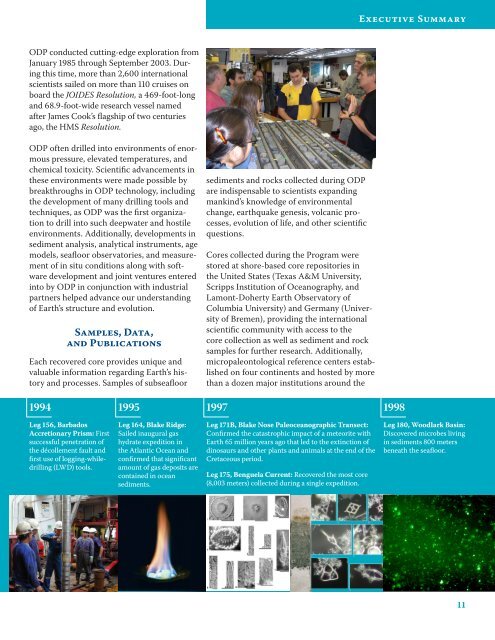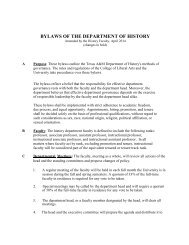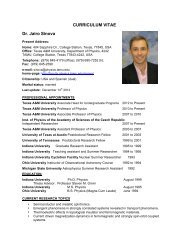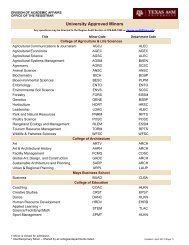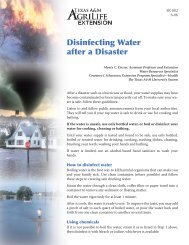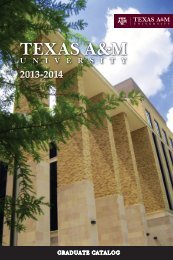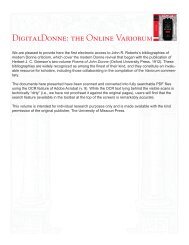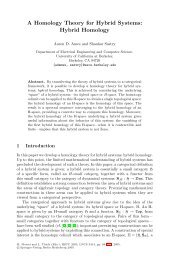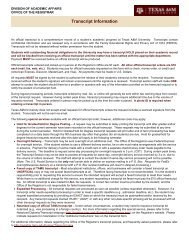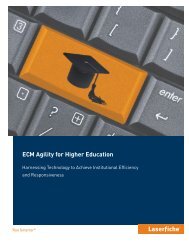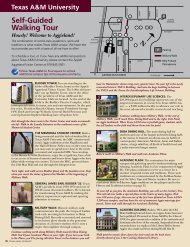ODP Final Technical Report - Ocean Drilling Program - Texas A&M ...
ODP Final Technical Report - Ocean Drilling Program - Texas A&M ...
ODP Final Technical Report - Ocean Drilling Program - Texas A&M ...
Create successful ePaper yourself
Turn your PDF publications into a flip-book with our unique Google optimized e-Paper software.
Executive Summary<strong>ODP</strong> conducted cutting-edge exploration fromJanuary 1985 through September 2003. Duringthis time, more than 2,600 internationalscientists sailed on more than 110 cruises onboard the JOIDES Resolution, a 469-foot-longand 68.9-foot-wide research vessel namedafter James Cook’s flagship of two centuriesago, the HMS Resolution.<strong>ODP</strong> often drilled into environments of enormouspressure, elevated temperatures, andchemical toxicity. Scientific advancements inthese environments were made possible bybreakthroughs in <strong>ODP</strong> technology, includingthe development of many drilling tools andtechniques, as <strong>ODP</strong> was the first organizationto drill into such deepwater and hostileenvironments. Additionally, developments insediment analysis, analytical instruments, agemodels, seafloor observatories, and measurementof in situ conditions along with softwaredevelopment and joint ventures enteredinto by <strong>ODP</strong> in conjunction with industrialpartners helped advance our understandingof Earth’s structure and evolution.Samples, Data,and PublicationsEach recovered core provides unique andvaluable information regarding Earth’s historyand processes. Samples of subseafloorsediments and rocks collected during <strong>ODP</strong>are indispensable to scientists expandingmankind’s knowledge of environmentalchange, earthquake genesis, volcanic processes,evolution of life, and other scientificquestions.Cores collected during the <strong>Program</strong> werestored at shore-based core repositories inthe United States (<strong>Texas</strong> A&M University,Scripps Institution of <strong>Ocean</strong>ography, andLamont-Doherty Earth Observatory ofColumbia University) and Germany (Universityof Bremen), providing the internationalscientific community with access to thecore collection as well as sediment and rocksamples for further research. Additionally,micropaleontological reference centers establishedon four continents and hosted by morethan a dozen major institutions around the19941995 19971998Leg 156, BarbadosAccretionary Prism: Firstsuccessful penetration ofthe décollement fault andfirst use of logging-whiledrilling(LWD) tools.Leg 164, Blake Ridge:Sailed inaugural gashydrate expedition inthe Atlantic <strong>Ocean</strong> andconfirmed that significantamount of gas deposits arecontained in oceansediments.Leg 171B, Blake Nose Paleoceanographic Transect:Confirmed the catastrophic impact of a meteorite withEarth 65 million years ago that led to the extinction ofdinosaurs and other plants and animals at the end of theCretaceous period.Leg 175, Benguela Current: Recovered the most core(8,003 meters) collected during a single expedition.Leg 180, Woodlark Basin:Discovered microbes livingin sediments 800 metersbeneath the seafloor.11


